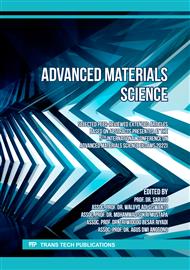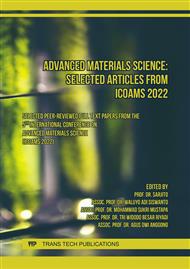[1]
P. S. Murthy and M. Madhava Naidu, Sustainable management of coffee industry by-products and value addition—A review, Resour. Conserv. Recycling., 66 (2012), 45-58.
DOI: 10.1016/j.resconrec.2012.06.005
Google Scholar
[2]
International Coffee Organization, World coffee consumption, (2022), https://www.ico.org/prices/new-consumption-table.pdf (accessed 08/14/2022).
Google Scholar
[3]
M. Hoseini, S. Cocco, C. Casucci, V. Cardelli, and G. Corti, Coffee by-products derived resources. A review, Biomass Bioenergy, 148 (2021), 106009.
DOI: 10.1016/j.biombioe.2021.106009
Google Scholar
[4]
D. V. Nguyen, H. N. Do, H. N. Do, and L. Q. Nguyen, One-step preparation of rice husk-based magnetic biochar and its catalytic activity for p-nitrophenol degradation, Chem. Eng. Trans., 78 (2020), 379-384.
Google Scholar
[5]
M. H. Nguyen, T. L. Nguyen, T. K. L. Nguyen, H. H. Lam, T. M. Tran-Thuy, Q. L. Nguyen, and D. V. Nguyen, Facile preparation of lotus seedpod-derived magnetic porous carbon for catalytic oxidation of Ponceau 4R, IOP Conf. Ser. Earth Environ. Sci., 947(1) (2021), 012019.
DOI: 10.1088/1755-1315/947/1/012019
Google Scholar
[6]
W. Astuti, T. Sulistyaningsih, D. Prastiyanto, B. S. A. Purba, and R. Kusumawardani, Synthesis of magnetically separable activated carbon from pineapple crown leaf for zinc ion removal, Mater. Sci. Forum, 1007 (2020), 71-75.
DOI: 10.4028/www.scientific.net/msf.1007.71
Google Scholar
[7]
Z. Feng, R. Yuan, F. Wang, Z. Chen, B. Zhou, and H. Chen, Preparation of magnetic biochar and its application in catalytic degradation of organic pollutants: A review, Sci. Total Environ., 765 (2021), 142673.
DOI: 10.1016/j.scitotenv.2020.142673
Google Scholar
[8]
A. G. Kumi, M. G. Ibrahim, M. Nasr, and M. Fujii, Biochar synthesis for industrial wastewater treatment: A critical review, Mater. Sci. Forum, 1008 (2020), 202-212.
DOI: 10.4028/www.scientific.net/msf.1008.202
Google Scholar
[9]
S. Dawadi, S. Katuwal, A. Gupta, U. Lamichhane, R. Thapa, S. Jaisi, G. Lamichhane, D. P. Bhattarai, and N. Parajuli, Current research on silver nanoparticles: Synthesis, characterization, and applications, J. Nanomater., 2021 (2021), 6687290.
DOI: 10.1155/2021/6687290
Google Scholar
[10]
G. Liao, J. Fang, Q. Li, S. Li, Z. Xu, and B. Fang, Ag-based nanocomposites: Synthesis and applications in catalysis, Nanoscale, 11(15) (2019), 7062-7096.
DOI: 10.1039/c9nr01408j
Google Scholar
[11]
P. Raveendran, J. Fu, and S. L. Wallen, A simple and green, method for the synthesis of Au, Ag, and Au–Ag alloy nanoparticles, Green Chem., 8(1) (2006), 34-38.
DOI: 10.1039/b512540e
Google Scholar
[12]
P. Raveendran, J. Fu, and S. L. Wallen, Completely green, synthesis and stabilization of metal nanoparticles, J. Am. Chem. Soc., 125(46) (2003), 13940-13941.
DOI: 10.1021/ja029267j
Google Scholar
[13]
J. N. Solanki and Z. V. P. Murthy, Highly monodisperse and sub-nano silver particles synthesis via microemulsion technique, Colloids Surf. A: Physicochem. Eng. Asp., 359(1) (2010), 31-38.
DOI: 10.1016/j.colsurfa.2010.01.058
Google Scholar
[14]
S.-F. Jiang, L.-L. Ling, Z. Xu, W.-J. Liu, and H. Jiang, Enhancing the catalytic activity and stability of noble metal nanoparticles by the strong interaction of magnetic biochar support, Ind. Eng. Chem. Res., 57(39) (2018), 13055-13064.
DOI: 10.1021/acs.iecr.8b02777
Google Scholar
[15]
W. Kim, C.-Y. Suh, S.-W. Cho, K.-M. Roh, H. Kwon, K. Song, and I.-J. Shon, A new method for the identification and quantification of magnetite–maghemite mixture using conventional X-ray diffraction technique, Talanta, 94 (2012), 348-352.
DOI: 10.1016/j.talanta.2012.03.001
Google Scholar
[16]
A. Inoue and F. Kong, Soft Magnetic Materials,, in Encyclopedia of Smart Materials, A.-G. Olabi Ed. Oxford: Elsevier, 2022, pp.10-23.
Google Scholar
[17]
B. S. Yadav, R. Singh, A. K. Vishwakarma, and N. Kumar, Facile synthesis of substantially magnetic hollow nanospheres of maghemite (γ-Fe2O3) originated from magnetite (Fe3O4) via solvothermal method, J. Supercond. Nov. Magn., 33(7) (2020), 2199-2208.
DOI: 10.1007/s10948-020-05481-7
Google Scholar
[18]
A. Kajiyama and T. Nakamura, Hydrothermal synthesis of β-FeO(OH) rod-like particles with uniform size distribution, Colloids Surf. A: Physicochem. Eng. Asp., 163(2) (2000), 301-307.
DOI: 10.1016/s0927-7757(99)00303-9
Google Scholar
[19]
M. Tadic, M. Panjan, V. Damnjanovic, and I. Milosevic, Magnetic properties of hematite (α-Fe2O3) nanoparticles prepared by hydrothermal synthesis method, Appl. Surf. Sci., 320 (2014), 183-187.
DOI: 10.1016/j.apsusc.2014.08.193
Google Scholar
[20]
J. Bedia, M. Peñas-Garzón, A. Gómez-Avilés, J. J. Rodriguez, and C. Belver, Review on activated carbons by chemical activation with FeCl3, C, 6(2) (2020), 21.
DOI: 10.3390/c6020021
Google Scholar
[21]
M. Ghaedi and N. Mosallanejad, Study of competitive adsorption of malachite green and sunset yellow dyes on cadmium hydroxide nanowires loaded on activated carbon, J. Ind. Eng. Chem., 20(3) (2014), 1085-1096.
DOI: 10.1016/j.jiec.2013.06.046
Google Scholar
[22]
J. Feng, X. Hu, and P. L. Yue, Discoloration and mineralization of orange II using different heterogeneous catalysts containing Fe: A comparative study, Environ. Sci. Technol., 38(21) (2004), 5773-5778.
DOI: 10.1021/es049811j
Google Scholar
[23]
R. Matta, K. Hanna, and S. Chiron, Fenton-like oxidation of 2,4,6-trinitrotoluene using different iron minerals, Sci. Total Environ., 385(1) (2007), 242-251.
DOI: 10.1016/j.scitotenv.2007.06.030
Google Scholar



